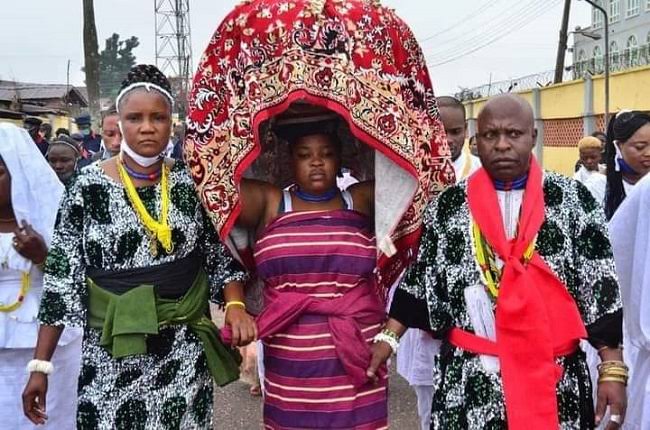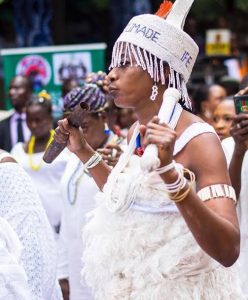
Osun-Osogbo: Blend of Culture, Spirituality, Performance
Ore Yeeyee ooo (the goodness of the mother)
Osun o,
Ota o,
Eri o,
Agba ooo,
Omi ooo…
For anyone who has come across Osun devotees in their performance, this praise chant chorus will not be strange to the ears. For the devotees to intermittently acknowledge “the goodness of the mother” she must be so kind! What sort of goodness has she been so committed to which earned her these constant adulations and an annual festival? Who is even this so much celebrated mother? A goddess! Her worship transcends South West Nigeria, variations of her name, understandably due to slave trade, are found in Brazil—Oxum—and Cuba—Ochun.
In Yoruba spiritual experience, deities have their respective totems and specialisations which are the rallying points to their adherents. For example, Ogun “the God of Iron” has most of its adherents among professionals whose main instruments of works are made of iron; hunters and blacksmiths readily come to the mind. A hunter who has a fruitful game hunting hails Ogun for the success; “Ogun Yeee” (Ogun is alive) is the regular chant to acknowledge the deity’s gesture.
For Osun it is water, purity and fertility! This goddess resides in the river and is believed to be a mother who gives out children and other goodies to mortals who have made their supplications. In the Yoruba mythology this goddess is believed to have once lived as a wife to Sango (the god of Thunder) but later turned to a river for her deification. Osogbo, the capital of Osun State named after this deity, in the Southwestern part of Nigeria, is the spiritual site of worship for Osun devotees.

Every August, Osun-Osogbo Festival brings together all Isese (traditional religion) faithful and indeed Osun devotees across the world as well as tourists and cultural enthusiasts for the celebration of this goddess. Just like Christmas/Easter, Eid-el-Kabir, Agemo, etc, and other religious festivities, Osun-Osogbo Festival is the annual rededication of self to and renewal of covenant with this riverine deity. The euphoria is often surrounded by the termination of the long wait for those eager to present their supplications and thanksgiving period for those who have had their requests granted.
The all white attire of the devotees speaks to the purity the deity symbolises, the chants (esa) renders poetic adulations and the offerings (sacrifices) make a seal of covenant between the offerer and offeree. The procession of Arugba, Ataoja, thousands of worshipers and cultural enthusiasts to the sacred Osun-Osogbo Groove, the abode of the deity, is the mark of communal unity/bond in faith and submission to the deity.

Arugba is a virgin maid who carries a Calabash from Ataoja’s (the king) place to Osun river in the sacred groove. She is at the centre of the procession to the groove and stands as an intermediary between the community and the deity. Arugba’s virginity/innocence further underscores the symbol of purity of the deity. On the day of the festival, she conveys the communal sacrifice and individuals’ requests to the river. As she makes her procession, people present their requests to the deity for consideration.
A devotee’s soul can temporarily transit to commune with the spirits, leaving the control of the body and soul to Osun. Only the soul knows what happens during the encounter with Osun’s spirit while the conscious body may never know. You may call it trance.

The sacredness of the groove itself makes it a befitting home for the deity. The countless trees that have aged enough to receive their individual sacrifices from humans, the dead silence like Aginju Idakeroro (Forest of Silence) in D.O Fagunwa’s “Igbo Olodumare”, the strange birds that can easily cause a scare in the metropolis, the art works (ere) representing different Yoruba deities built by Adunni Olorisa (Susanne Wenger, the Austrian), the numerous giant ants and other creatures that make the tropical forest home, raise the spiritual significance of the groove. In 2005, the UNESCO declared the groove a World Heritage Site. This is where many believers consider as their “holy land” where they go on annual pilgrimage.
Besides the spirituality of this festival, it is a ground for raw entertainment for tourists across races and religious divides. The root of African drama, which has evolved to film production, is in festival. If you have been privileged to attend any Egungun (masquerade) festival you will agree that it is pure performance! The dance, acrobats, sudden frightening scream and movement, and the interesting display of connection between the masquerades and drummers, are all elements of performance. If you have not experienced Egungun Festival, you can visit Ibadan, Oyo State capital in Nigeria, in August for premium entertainment.
Osun-Osogbo like other traditional festivals also has elements of performance. The priests and priestesses have a mastery of the praise chants of this deity in a poetic form. With their jingling bell, they render the chants with sonorous voices to praise and summon the spirit of this goddess of purity and fertility.
Ore yeye osun. (The goodness of Mother osun)
Osun sengese (Praise to the mother of mystery)
Oloriya iyun, (The one who has comb made of coral beads)
Arewa obinrin, (The beautiful lady.)
Osun oyeeyee nimo (Osun the very knowledgeable one)
Awede wemo. (Spirits that cleans me inside out.)
Amidst the euphoria, the drummers with expertise in Bata, Gangan, Bembe and Iya Ilu create a frenzy atmosphere for the attendees who sing in excitement. Festivals are a symbol of celebration; celebration of communality, heritage, root, identity and spirituality. This is the area of interest to many tourists, especially foreigners, whose curiosity is fed by the uniqueness and beauty of African culture and spirituality.
Like other religions which emerged from different cultures across the world, Osun devotees practice their spirituality as understood through the prism of the Yoruba cultural reality. Do not define them as barbaric or uncivilised because many of the worshippers regularly give testimonies on how the deity has granted them their requests. The consistent large turnout of people recorded underscores the significance and relevance of the festival to the cultural and spiritual existence of the people. Through them the people’s legend, myth and belief system are protected from erasure.
Ajibewaji (One who wakes with beauty)
Alagbo aweye, (One who uses herbs to bathe for life sustainance)
Ladekoju ebora tin gbe’nu omi (Ladekoju, a strange creature who resides in the river)
Ewudi alapo’lodo
Apiroro bi eni n sun (One who pretends to sleep)…